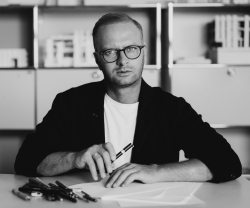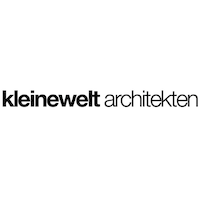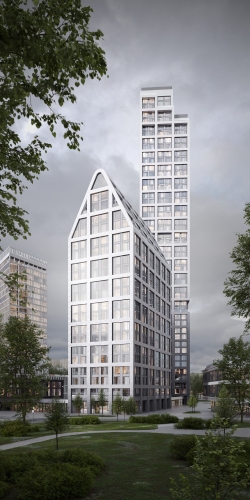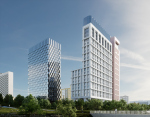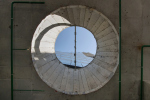Nikolay Pereslegin
information:
-
country
Russia -
FirmТs Official Site
http://www.kleinewelt.ru/ -
Ѕлог pereslegin.com
Architect, partner and co-founder of Kleinewelt Architekten, PhD in Architecture, professor at the Moscow Architectural Institute (MArchI)
Nikolay Pereslegin graduated from the Moscow Architectural Institute (MArchI) in 2008, where he studied under professors Andrey Nekrasov and Alexander Tsybaikin, as well as Yuri Grigoryan and Alexandra Pavlova.
In 2015, he defended his PhD dissertation at MArchI on “The history of the formation and development of architectural heritage protection bodies in Moscow in the context of their interaction with society during the Soviet period (1917-1991)”, under the supervision of academician Dmitry Shvidkovsky.
Pereslegin is a laureate of the Venice Architecture Biennale (2004), as well as numerous national and international architecture competitions. He has received the Russian President’s Prize for his contribution to the development of national architecture and the preservation of cultural heritage. He is a professor at the International Academy of Architecture (IAA), a member of the Union of Architects of Russia, and a member of the All-Russian Society for the Preservation of Historical and Cultural Monuments.
Pereslegin teaches at MArchI at the Department of Residential and Public Buildings.
In 2012, together with Sergey Pereslegin and Georgy Trofimov, Nikolay Pereslegin co-founded the architecture firm Kleinewelt Architekten.
Nikolay Pereslegin graduated from the Moscow Architectural Institute (MArchI) in 2008, where he studied under professors Andrey Nekrasov and Alexander Tsybaikin, as well as Yuri Grigoryan and Alexandra Pavlova.
In 2015, he defended his PhD dissertation at MArchI on “The history of the formation and development of architectural heritage protection bodies in Moscow in the context of their interaction with society during the Soviet period (1917-1991)”, under the supervision of academician Dmitry Shvidkovsky.
Pereslegin is a laureate of the Venice Architecture Biennale (2004), as well as numerous national and international architecture competitions. He has received the Russian President’s Prize for his contribution to the development of national architecture and the preservation of cultural heritage. He is a professor at the International Academy of Architecture (IAA), a member of the Union of Architects of Russia, and a member of the All-Russian Society for the Preservation of Historical and Cultural Monuments.
Pereslegin teaches at MArchI at the Department of Residential and Public Buildings.
In 2012, together with Sergey Pereslegin and Georgy Trofimov, Nikolay Pereslegin co-founded the architecture firm Kleinewelt Architekten.
Archi.ru Texts:
23.10.2025
Julia Tarabarina. The Silver Skates
The STONE Kaluzhskaya office quarter is accompanied by two residential towers, making the complex Ц for it is indeed a single ensemble Ц well balanced in functional terms. The architects at Kleinewelt gave the residential buildings a silvery finish to match the office blocks. How they are similar, how they differ, and what УSilver SkatesФ has to do with it Ц we explore in this article.05.09.2025
. The Keystone
Until quite recently, premium residential and office complexes in Moscow were seen as the exclusive privilege of the city center. Today the situation is changing: high-quality architecture is moving beyond the confines of the Third Ring Road and appearing on the outskirts. The STONE Kaluzhskaya business center is one such example. Projects like this help decentralize the megalopolis, making life and work prestigious in any part of the city.03.07.2025
. Peaceful Integration on Mira Avenue
The MIRA residential complex (the word mir means УpeaceФ in Russian), perched above the steep banks of the Yauza River and Mira Avenue, lives up to its name not only technically, but also visually and conceptually. Sleek, high-rise, and glass-clad, it responds both to ZholtovskyТs classicism and to the modernism of the nearby УHouse on StiltsФ. Drawing on features from its neighbors, it reconciles them within a shared architectural language rooted in contemporary façade design. LetТs take a closer look at how this is done.04.06.2025
Julia Tarabarina. Skylights and Staircase
Photos from March show the nearly completed headquarters of FSK Group on Shenogina Street. The buildingТs exterior is calm and minimalist; the interior is engaging and multi-layered. The conical skylights of the executive office, cast in raw concrete, and the sweeping spiral staircase leading to it, are particularly striking. In fact, thereТs more than one spiral staircase here, and the first two floors effectively form a small shopping center. More below.06.05.2025
Julia Tarabarina. The Colorful City
While working on a large-scale project in MoscowТs Kuntsevo district Ц one that has yet to be given a name Ц Kleinewelt Architekten proposed not only a diverse array of tower silhouettes in УEmpire-styleФ hues and a thoughtful mix of building heights, creating a six-story Уneo-urbanistФ city with a block-based layout at ground level, but also rooted their design in historical and contextual reasoning. The project includes the reconstruction of several Stalin-era residential buildings that remain from the postwar town of Kuntsevo, as well as the reconstruction of a 1953 railway station that was demolished in 2017.see All Archi.ru Texts / Nikolay Pereslegin
